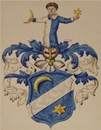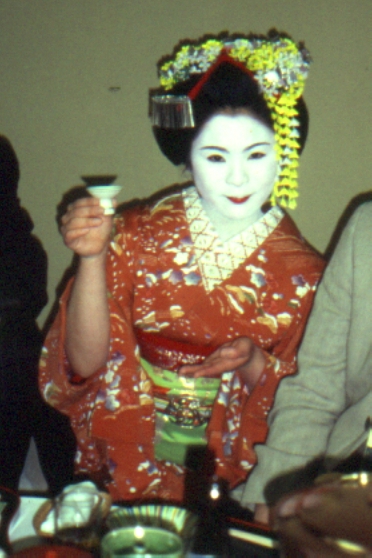|
Es scheint, dass du nach Informationen über Meiko (舞子
oder 名妓), also Schülerinnen einer Geisha (芸者),
suchst. Hier ist eine ausführliche Erklärung:
🔹 Was ist eine Meiko (舞子)?
-
Definition: Eine Meiko (auch "Maiko" geschrieben)
ist eine Auszubildende zur Geisha,
meist im Alter zwischen 15 und 20 Jahren.
-
Region: Besonders bekannt in Kyoto (Gion,
Pontochō), wo die Tradition am strengsten gelebt wird.
-
Aufgaben: Sie lernt traditionelle Künste wie Tanz (Buyō),
Musik (Shamisen, Gesang*) und Teezeremonie, während sie
Geishas (Geiko in Kyoto) assistiert.
🔹 Unterschied zwischen Maiko & Geisha/Geiko
|
Aspekt |
Maiko (Meiko) |
Geisha/Geiko |
|
Alter |
15–20 Jahre |
Ab ~20–21 Jahren |
|
Frisur |
Natürliches Haar mit aufwendigen Ornamenten (Kanzashi) |
Perücke (Katsura) |
|
Kleidung |
Langer, bunter Obi (Schleife), lange Ärmel |
Kürzerer Obi, schlichtere Kimonos |
|
Make-up |
Starke weiße Basis, rotes Unterlid (unverheiratet) |
Natürlicher, nur bei Auftritten volles Make-up |
|
Schuhe |
Okobo (hohe Holzsandalen) |
Zori (flachere Sandalen) |
🔹 Ausbildung & Alltag einer Meiko
-
Eintritt: Beginnt oft mit 15–16
Jahren in einem Geisha-Haus (Okiya).
-
Mentorin: Eine "Onee-san" (ältere
Geisha) unterweist sie.
-
Training:
-
Debüt: Nach etwa 1–2 Jahren tritt
sie erstmals bei Banketten (Ozashiki) auf.
🔹 Berühmte Meiko & Geisha-Viertel
-
Gion (Kyoto): Das bekannteste Geisha-Viertel (Film "Memoirs
of a Geisha").
-
Pontochō & Miyagawachō: Weitere traditionelle
Hanamachi („Blumenstraßen“) in Kyoto.
-
Fumikazu: Eine berühmte moderne Maiko, die auf
Instagram aktiv ist (@fumikazu_maiko).
🔹 Moderne Entwicklungen & Missverständnisse
-
Keine Prostituierten: Geishas sind Künstlerinnen,
keine Begleiterinnen (ein häufiges Klischee).
-
Rückgang der Tradition: Heute gibt es nur noch ~200
Maiko in ganz Japan.
-
Tourismus: In Kyoto können Touristen Maiko-Darbietungen buchen
(z. B. im Gion Corner).
🔹 Wo kann man Meikos sehen?
✔ Kyoto (Gion) – Abends auf
dem Weg zu Teehäusern.
✔ Festivals (z.
B. Miyako Odori –
Maiko-Tanzvorführung im April).
✔ Kinos & Dokus: "Memoirs
of a Geisha" (2005), "A Geisha’s
Journey" (Netflix).
|
|
|
A
Meiko is a
young apprentice or
novice Geisha in Japan,
typically in the Kyoto
area, particularly in the historic
Gion district. The term
Meiko is most commonly
associated with the Geisha
tradition, although the term for male apprentices would be
Maiko for female
apprentices. Geisha are
highly skilled female entertainers trained in traditional Japanese arts,
including classical music,
dance, and
tea ceremony.
What is a Meiko?
-
Meiko are
essentially the apprentice
Geishas who are still in training and learning the arts
required to become a full-fledged Geisha. A
Meiko is typically
younger, around 15 to 20
years old, and is still under the tutelage of a more
experienced Geisha
(known as "Geiko"
in Kyoto dialect).
Key Characteristics and Roles of
a Meiko:
-
Appearance:
-
Meiko are usually
distinguished by their
colorful kimonos,
obis (broad
sashes), and ornate
hairpieces called
kanzashi. The
style of the kimono worn by Meiko is generally more decorative
and vibrant, often featuring rich patterns and accessories.
-
Obi: Meiko
wear a wide obi
(sash) that is tied in an elaborate knot at the back, which
gradually becomes narrower as they transition into a Geiko.
-
Makeup:
Meiko's makeup
is not as elaborate as a fully established Geisha's. Their face
is often painted with
white rice powder,
red and black accents
around the eyes, and the
lips are red
in a distinct, smaller shape.
-
Hairstyle:
The hair of a Meiko is styled in
intricate traditional
patterns and adorned with
kanzashi
(decorative hairpins and ornaments). The style may evolve as she
progresses in her training.
-
Training:
-
Meiko are in
intensive
apprenticeship and spend years learning various
traditional arts, including playing
Shamisen (a
three-stringed instrument),
classical Japanese
dance,
singing, tea
ceremony,
calligraphy, and
poetry.
-
They are also
trained in etiquette,
social interaction,
and conversation
to engage clients during tea ceremonies or other social
gatherings. Their training is passed down from older Geishas or
a Geisha house
(called an Okiya).
-
Duties:
-
During their
apprenticeship, Meiko often work in
banquets,
teahouses,
and private events
where they provide entertainment. They perform dances, play
music, serve drinks, and engage in light conversation with
guests to ensure that the atmosphere is lively and refined.
-
Progression to Geiko:
-
Over time, as a
Meiko gains experience and masters the arts, she will be able to
become a Geiko,
which is the full-fledged title for a senior Geisha. This
transition often happens after several years of apprenticeship,
marked by changing
their attire (from the colorful Meiko kimono to the
more subdued and formal Geiko kimono) and
adjusting their
hairstyles.
-
Geiko are
generally more experienced and polished, wearing
more minimalist
kimonos and
formal hairstyles. They may also perform at more
prestigious or exclusive events.
Geisha Culture and History:
-
The
Geisha tradition
dates back to the 17th
century and has evolved over the centuries. Geisha were
initially entertainers
of the upper classes, including the samurai and merchant classes,
and were skilled in various traditional arts.
-
They have
traditionally served as companions at
banquets,
tea ceremonies,
and other social
gatherings, providing not just entertainment, but also
conversation, cultural
education, and a sense of
refined hospitality.
Meiko and Geisha in Modern
Japan:
-
Today, the
Meiko and
Geisha tradition
is more preserved
and celebrated as a
cultural heritage, especially in
Kyoto, which
remains one of the most prominent areas for Geisha culture. While
their role in society has changed, there are still opportunities to
experience Geisha
performances, whether through
private dinner parties
or public tea ceremonies.
-
Tourists in Kyoto
can witness Meiko and
Geisha at traditional
Geisha districts,
such as Gion and
Pontocho, where
they can sometimes catch glimpses of the
apprentices
heading to or from their engagements.
Geisha and Meiko in Popular
Culture:
-
The Geisha culture,
particularly the transition from
Meiko to
Geiko, has also
been popularized in movies and books, most notably in
"Memoirs of a Geisha"
by Arthur Golden,
which tells the story of a young girl becoming a Geisha.
-
The
Meiko figure is
often romanticized in popular media, symbolizing
grace,
elegance, and
traditional Japanese
beauty. While the realities of being a Meiko or Geiko are
much more demanding and require years of dedication, they still
remain a significant symbol of Japan’s cultural legacy.
Conclusion:
A
Meiko is an
apprentice Geisha,
undergoing rigorous training in the arts of
music,
dance, and
etiquette. The
transition from Meiko to Geiko
signifies the mastery of these arts, and the young Meiko embodies a
blend of youthful grace and dedication to preserving Japan’s traditional
entertainment culture. This role, while rooted in history, still thrives
in places like Kyoto, where the artistry and tradition of the Geisha
continue to captivate audiences worldwide.
|
|
 Safaris
Bergsteigen
Wandern
Inselwandern Weltweit
Safaris
Bergsteigen
Wandern
Inselwandern Weltweit
 Europa
Inselwandern
Europa
Inselwandern
 Städtewandern
Städtewandern
 Paintings
Paintings Dirk Rauschenbach
Dirk Rauschenbach
 Safaris
Bergsteigen
Wandern
Inselwandern Weltweit
Safaris
Bergsteigen
Wandern
Inselwandern Weltweit
 Europa
Inselwandern
Europa
Inselwandern
 Städtewandern
Städtewandern
 Paintings
Paintings Dirk Rauschenbach
Dirk Rauschenbach

![]() 26.07.25 Copyright Dirk
Rauschenbach Koelnerstrasse 293 51702 Bergneustadt
Datenschutzerklaerung 02261 9788972 Mail ccooly(
at) web.de
26.07.25 Copyright Dirk
Rauschenbach Koelnerstrasse 293 51702 Bergneustadt
Datenschutzerklaerung 02261 9788972 Mail ccooly(
at) web.de